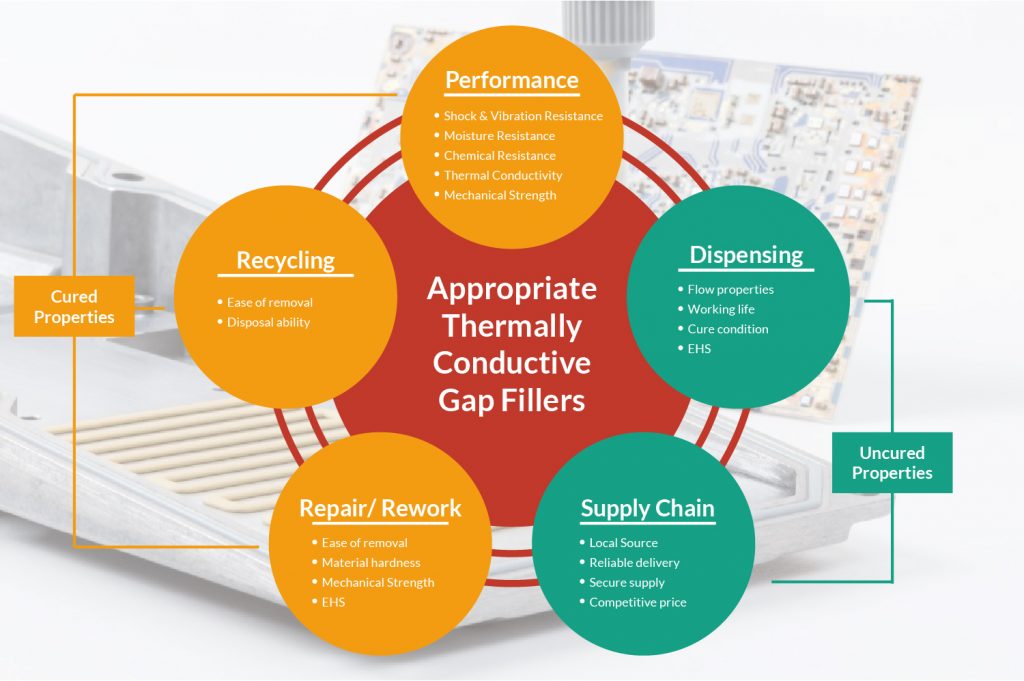How to choose the right Thermally Conductive Gap Filler in the various options?
Nowadays, the demands and use of thermal interface materials (TIMs) in automobile, consumer electronic, telecom equipment and LED light industries have dramatically increased. Despite the general demand for higher production throughput, each industry and application has different requirements for TIMs, especially Thermally Conductive Gap Filler: thinner bondlines, reduced mechanical pressure on components and solder joints, or easy to dispense for mass production.
Because there are no standardized construction and requirements for TGF, your requirements of a gap filler may also be unique. Choosing or developing the best gap filler to meet all of your needs requires consideration of a number of aspects, as shown in the figure below.
Generally, the considerations will be divided into 5 groups which will be controlled by 2 main properties of a Thermally Conductive Gap Filler: Cured Properties and Uncured Properties.


At first, manufacturers should refer to the CURED PROPERTIES to select the TGFs which have suitable features that directly affect the end-products.
Performance of end-products
The performance of the finished product is usually the initial consideration. It is essential to consider the working environment of end-products and define the need of:
- Safety
- Shock & Vibration resistance
- Moisture resistance
- Chemical resistance
- Level of thermal conductivity
- Mechanical Fastening
- Low stress on the component
- Thermal cycling performance
- Insulation
All this information will be the very first consideration when selecting the right TGF. However, each of these features will be in conjunction with the cured properties of TGFs:
Safety | Flammability |
Effect on Customer Product Performance | Cured Material Properties |
Shock & Vibration Performance Mechanical Fastening | Hardness |
Tensile Strength/ Elongation/ Young’s Modulus | |
Storage Modulus | |
Bonding Strength | |
Moisture & Chemical Resistant Performance | Gap Filler Chemical Options |
The thickness of Dispensed Materials | |
Level of thermal conductivity | Thermally Conductive Index |
The thickness of Dispensed Materials | |
Thermal cycling performance
| Glass Transition Temperature, Tg |
Tensile Strength/Elongation/Young’s Modulus | |
Insulation | Electrical resistance (volume resistivity, breakdown voltage) |
Rework, Repair, and Recycling Demand
Undoubtedly, the cured properties will also affect the ability to repair, rework, and recycle the end-product either during manufacture or at the end of life.
When considering the repair and rework demand, manufacturers need a material that has the ability of Ease of removal, Materials hardness, Material adhesion, EHS. On the other hand, excellent recycling material needs features: easy to remove and disposal (relating to sustainable development). As a result, these abilities will relate to the following features and specifications of TGFs:
Type of Gap Filler Chemistry
There are several polymers chemistry types to select. However, the two most relevant types for gap fillers are silicone and urethane polymers.
Silicones gap filler
are generally mechanically soft materials when cured so that they exert low stress on delicate components. The features of silicone can be advantages of this application but disadvantages of the other applications. For example:
- They have low adhesive strength, which means that some type of mechanical fastening will be needed to hold components in place; it also means that they are quite easy to rework, repair, and recycle.
- Their moisture resistance is good but their resistance to chemicals is poor.
- Several silicone-based gap fillers are also available with very low volatile content, which means they can be used without concern about other coating or painting processes.
Polyurethane gap filler
- Have better adhesion and chemical resistance than silicones.
- They can also be relatively soft and reworkable, although their higher adhesion may create challenges.
- Their high-temperature limit (about 130°C) is not as good as silicones (above 200°C)
In conclusion, the main criteria for choosing between silicone and polyurethane gap fillers will therefore be the customer requirements for chemical exposure, adhesion, and reworkability.
Mechanical Properties
This will also affect the ability to repair and/or recycle components. Harder materials with greater adhesion may make it difficult to disassemble parts without damaging them or to remove traces of material from the individual parts.
It is therefore necessary to consider potential rework or repair concerns early in the design of the end-product so that the mechanical structure and the gap filler material properties can be optimized together.
Above is a part of the selection guide for TGFs, another important criteria manufacturers need to consider is Uncured Materials Properties, which will affect the Assembly Process and Supply Chain Service.
Choosing an optimal gap filler can be a challenging task, so utilizing a materials expert to assist is a recommended approach. Our Application Engineers are trained in both the chemistry and the application of our products, including our gap fillers, and their job is to understand customer requirements and applications in sufficient detail to permit the proper choice of material.
Contact us for free technical consultant




